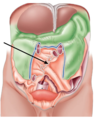Peritoneal Cavity Flashcards
What is the peritoneum?
thin serous membrane
What does pariteal peritoneum line?
walls of the abdominal and pelvic cavities
What does the visceral peritoneum line?
viscera (organs)
What is the space between the pariteal and visceral peritoneum called?
peritoneal cavity
Describe the peritoneal cavity in males
completely closed
Describe the peritoneal cavity in females
there is potential indirect communication with the exterior
What is the peritoneal cavity divided into?
greater and lesser sacs
What does the peritoneal cavity secrete?
small amount of serous fluid known as peritoneal fluid
What is the function of peritoneal fluid?
lubricates the surfaces of the peritoneum to allow distension and free movement beyween the viscera (organs)
what are the three main structures formed by the peritoneum?
- omenta (greater and lesser)
- Mesenteries
- Ligaments (peritoneal folds)
What is the peritoneal cavity and what is it divided into?
biggest cavity in the body
- greater sac
- lesser sac
What is the greater sac?
main compartment extending from the diaphragm into the pelvis
What is the lesser sac?
lies posterior to the stomach and lesser omentum but extends slightly into the greater omentum

red = greater sac
blue = lesser sac
What are the main properties of the peritoneal cavity?
- can be used for peritoneal dialysis and fluid administration
- spread of infections, cells or bleeding
Where is the lesser sac located?
posterior to the stomach and lesser omentum
How does the lesser sac communicate with the greater sac?
via epiploic foramen
Describe Pringle’s manouvre
During surgery the hepatic artery proper and portal vein can be compressed with fingers/haemostat to control bleefing
During surgery how can the lesser sac be approached?
via the epiploic foramen
Give 2 other names for the epiploic foramen
- omental foramen
- foramen of winslow
What is the anterior boundary of the epiploic foramen
- free border of lesser omentum, with the common bile duct
- hepatic artery
- portal vein
What is the posterior boundary of the epiploic foramen
inferior vena cava
What is the superior boundary of the epiploic foramen
caudate process of caudate love of liver
What is the inferior boundary of the epiploic foramen
first part of duodenum








